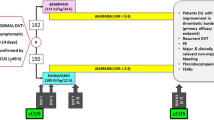Abstract
Clinical significance of distal deep vein thrombosis (DVT) is important as it can potentially result in pulmonary embolism (PE), DVT extension, DVT recurrence and post-thrombotic syndrome (PTS). Controversy remains about the necessity and modalities of anticoagulation in all distal DVT. Evaluation of the efficiency of a 40-day weight-based low molecular weight heparin (LMWH) treatment in a cohort of 119 consecutive patients with distal DVT. Compression ultrasonography of the lower limb was performed initially for diagnosis as well as at the end of the treatment to identify persistence or resolution of the blood clot. A 3-month follow-up estimated the rates of PE, DVT recurrence, DVT extension, PTS and bleeding. Risk factors for DVT were considered to evaluate a possible correlation between them and the outcomes. In 71.4% of the patients the blood clot was totally dissolved and thrombus persistence was statistically associated with the number of initially involved veins. DVT recurrence occurred in 5% of patients and was also associated with the number of initial clotted veins. DVT extension and PTS rates were present in 1.7% and 3.4% respectively and no patient was diagnosed with PE or bleeding. This retrospective study including a limited number of patients and no control group supports that a 40-day weight-based LMWH treatment after distal DVT seems to be efficient when one single vein is initially affected whereas for multiple vein distal DVT and to avoid potential DVT recurrence, longer than 6 weeks of anticoagulant treatment is required. Our results support safety of the treatment, its potential to prevent DVT extension and the occurrence of PE.



Similar content being viewed by others
References
Tapson VF (2008) Acute pulmonary embolism. N Engl J Med 358(10):1037–1052
Farrell JJ et al (2016) Incidence and interventions for post-thrombotic syndrome. Cardiovasc Diagn Ther 6(6):623–631
Vazquez SR, Kahn SR (2010) Postthrombotic syndrome. Circulation 121(8):e217–e219
Kearon C, Akl EA (2014) Duration of anticoagulant therapy for deep vein thrombosis and pulmonary embolism. Blood 123(12):1794–1801
Kearon C et al (2008) Antithrombotic therapy for venous thromboembolic disease: American College of Chest Physicians evidence-based clinical practice guidelines. Chest 133(6 Suppl):454S–545S
Kearon C et al (2012) Antithrombotic therapy for VTE disease: antithrombotic therapy and prevention of thrombosis, 9th ed: American College of Chest Physicians evidence-based clinical practice guidelines. Chest 141(2 Suppl):e419S–e496S
National CGCU (2012) Venous thromboembolic diseases: the management of venous thromboembolic diseases and the role of thrombophilia testing
Nicolaides AN et al (2013) Prevention and treatment of venous thromboembolism–International Consensus Statement. Int Angiol 32(2):111–260
Kearon C et al (2016) Antithrombotic therapy for VTE disease: CHEST guideline and expert panel report. Chest 149(2):315–352
Rabinovich A, Kahn SR (2014) How to predict and diagnose postthrombotic syndrome. Pol Arch Med Wewn 124(7–8):410–416
Yates D, Moore D, McCabe G (1999) The practice of statistics. W. H. Freeman, New York
Barco S et al (2019) Impact of sex, age, and risk factors for venous thromboembolism on the initial presentation of first isolated symptomatic acute deep vein thrombosis. Thromb Res 173:166–171
Galanaud JP et al (2009) Comparison of the clinical history of symptomatic isolated distal deep-vein thrombosis vs. proximal deep vein thrombosis in 11 086 patients. J Thromb Haemost 7(12):2028–2034
Ferrara F et al (2006) Optimal duration of treatment in surgical patients with calf venous thrombosis involving one or more veins. Angiology 57(4):418–423
Galanaud JP et al (2014) Incidence and predictors of venous thromboembolism recurrence after a first isolated distal deep vein thrombosis. J Thromb Haemost 12(4):436–443
Donadini MP et al (2017) Long-term recurrence of venous thromboembolism after short-term treatment of symptomatic isolated distal deep vein thrombosis: a cohort study. Vasc Med 22(6):518–524
Franco L et al (2017) Anticoagulation in patients with isolated distal deep vein thrombosis: a meta-analysis. J Thromb Haemost 15(6):1142–1154
Monreal M et al (1992) Deep venous thrombosis and the risk of pulmonary embolism. A systematic study. Chest 102(3):677–681
Righini M et al (2016) Anticoagulant therapy for symptomatic calf deep vein thrombosis (CACTUS): a randomised, double-blind, placebo-controlled trial. Lancet Haematol 3(12):e556–e562
Schwarz T et al (2010) Therapy of isolated calf muscle vein thrombosis: a randomized, controlled study. J Vasc Surg 52(5):1246–1250
Schwarz T et al (2001) Therapy of isolated calf muscle vein thrombosis with low-molecular-weight heparin. Blood Coagul Fibrinolysis 12(7):597–599
Palareti G et al (2010) Evolution of untreated calf deep-vein thrombosis in high risk symptomatic outpatients: the blind, prospective CALTHRO study. Thromb Haemost 104(5):1063–1070
Robert-Ebadi H, Righini M (2017) Management of distal deep vein thrombosis. Thromb Res 149:48–55
Palareti G (2014) How I treat isolated distal deep vein thrombosis (IDDVT). Blood 123(12):1802–1809
Poudel SK et al (2020) Clinical outcomes of isolated distal deep vein thrombosis versus proximal venous thromboembolism in cancer patients: The Cleveland Clinic experience. J Thromb Haemost 18(3):651–659
Author information
Authors and Affiliations
Corresponding author
Ethics declarations
Conflict of interest
The authors state that they have no conflict of interests.
Additional information
Publisher's Note
Springer Nature remains neutral with regard to jurisdictional claims in published maps and institutional affiliations.
Rights and permissions
About this article
Cite this article
Asonitis, K., Charvalos, E., Lambert, C. et al. Experience of a 40-day (6 week) LMWH treatment for isolated distal deep vein thrombosis. J Thromb Thrombolysis 50, 837–843 (2020). https://doi.org/10.1007/s11239-020-02089-5
Published:
Issue Date:
DOI: https://doi.org/10.1007/s11239-020-02089-5




